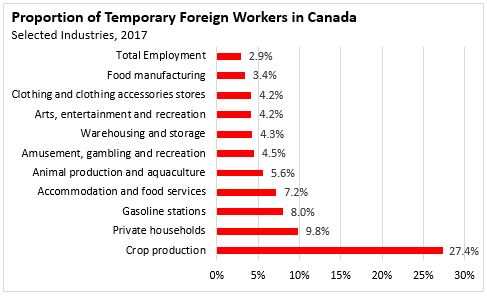The Economics and Statistics Division maintains archives of previous publications for accountability purposes, but makes no updates to keep these documents current with the latest data revisions from Statistics Canada. As a result, information in older documents may not be accurate. Please exercise caution when referring to older documents. For the latest information and historical data, please contact the individual listed to the right.
<--- Return to Archive
For additional information relating to this article, please contact:
June 03, 2020STUDY: THE DISTRIBUTION OF TEMPORARY FOREIGN WORKERS ACROSS INDUSTRIES IN CANADA In response to the COVID-19 pandemic, Statistics Canada completed a study on the distribution of temporary foreign workers (TFWs) across industries in Canada. Due to measures taken to contain the spread of the virus, the availability of new TFWs may be reduced or delayed in 2020.
TFWs have played an increasingly important role in the Canadian labour market in recent years with almost 470,000 work permits in 2019, up from 390,000 in 2018. Although TFWs account for a small share of the total workforce, they are particularly important in agriculture, forestry, fishing, and hunting, accounting for 15.5 per cent of employment in 2017. Among services-producing sectors, the highest proportion of TFWs was observed in accommodation and food services at 7.2 per cent.

Crop production had the highest proportion of TFWs in 2017, at 27.4 per cent nationwide. Provincially, TFWs accounted for 41.6 per cent of agricultural workers in Ontario, and over 30 per cent of agricultural workers in Quebec, British Columbia and Nova Scotia during the year. Among sectors that continue to operate during the COVID-19 pandemic, relatively high 2017 TFW employment was observed in private household services (9.8 per cent), gasoline stations (8 per cent), warehousing and storage (4.3 per cent), and food manufacturing (3.4 per cent).
When looking at firm level data, 17 per cent of employers in private household services (including cooks, maids, gardeners and nannies), and approximately 10 per cent of firms in crop production, gasoline stations, and food services and drinking places, had at least 30 per cent of their employees as TFWs in 2017.
Source: Statistics Canada. Study: The distribution of temporary foreign workers across industries in Canada
<--- Return to Archive